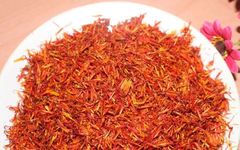Disease Inquiry, Health Guidance, Classic Health Preservation, Traditional Chinese Medicine and Herbal Medicine, Seeking Help When Sick
Safflower (Honghua) is a commonly used herb in daily life, known for its ability to invigorate blood circulation, regulate menstruation, and alleviate pain. Clinically, it is often used for conditions such as blood stasis leading to amenorrhea, dysmenorrhea, traumatic injuries, and rheumatic pain. Below, let us explore in detail the efficacy and functions of safflower.
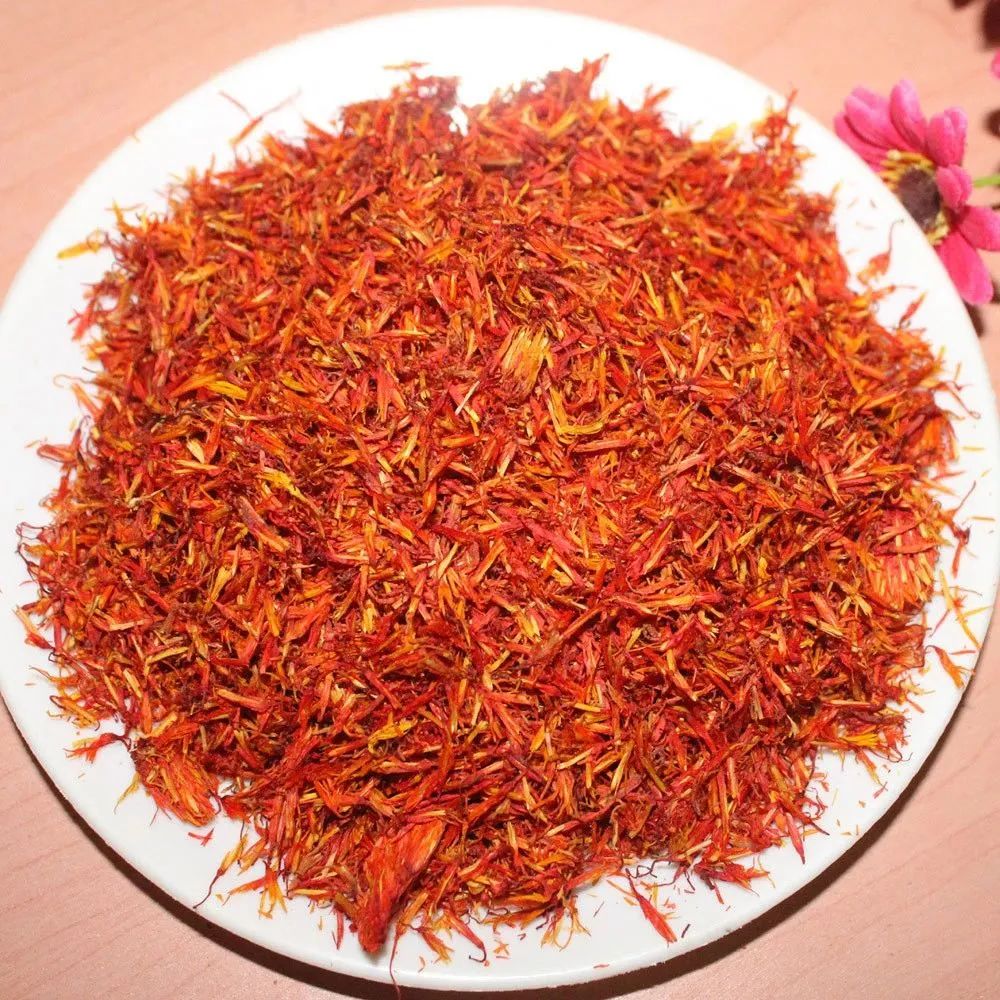
Safflower is also known as Honglanhua (红蓝花) in the “Essentials of Prescriptions from the Golden Chamber”, and Cihonghua (刺红花) in the “Four Prefectures of Chinese Medicine”. The medicinal part is the flower of the Asteraceae plant, harvested when the petals change from yellow to red in May to June, then dried in the sun, shade, or by baking.
The plant is an annual herb, growing 30 to 90 cm tall, with a smooth and hairless surface. The stem is erect, woody at the base, and branched at the top. The leaves are alternate, hard in texture, nearly stemless, and clasping the stem; they are ovate or ovate-lanceolate, measuring 3.5 to 9 cm in length and 1 to 3.5 cm in width, with a gradually narrowing base and a sharp tip, serrated edges; the upper leaves gradually reduce in size, forming bracts around the head-like flower cluster. The flower cluster is large and terminal, with many rows of involucral bracts, the outer 2 to 3 rows leaf-like and lanceolate with spiny edges; the inner rows are ovate, membranous and white-edged; the receptacle is flat; there are many tubular flowers, usually bisexual, orange-red, with 5 lobes at the tip, the lobes being linear; there are 5 stamens with fused anthers; 1 pistil with a slender style extending beyond the anther tube, with a bifid stigma, the lobes being short and tongue-like. The achene is oval or obovate, about 5 mm long, slightly oblique at the base, white, with 4 ribs. The flowering period is from June to July, and the fruiting period is from August to September.
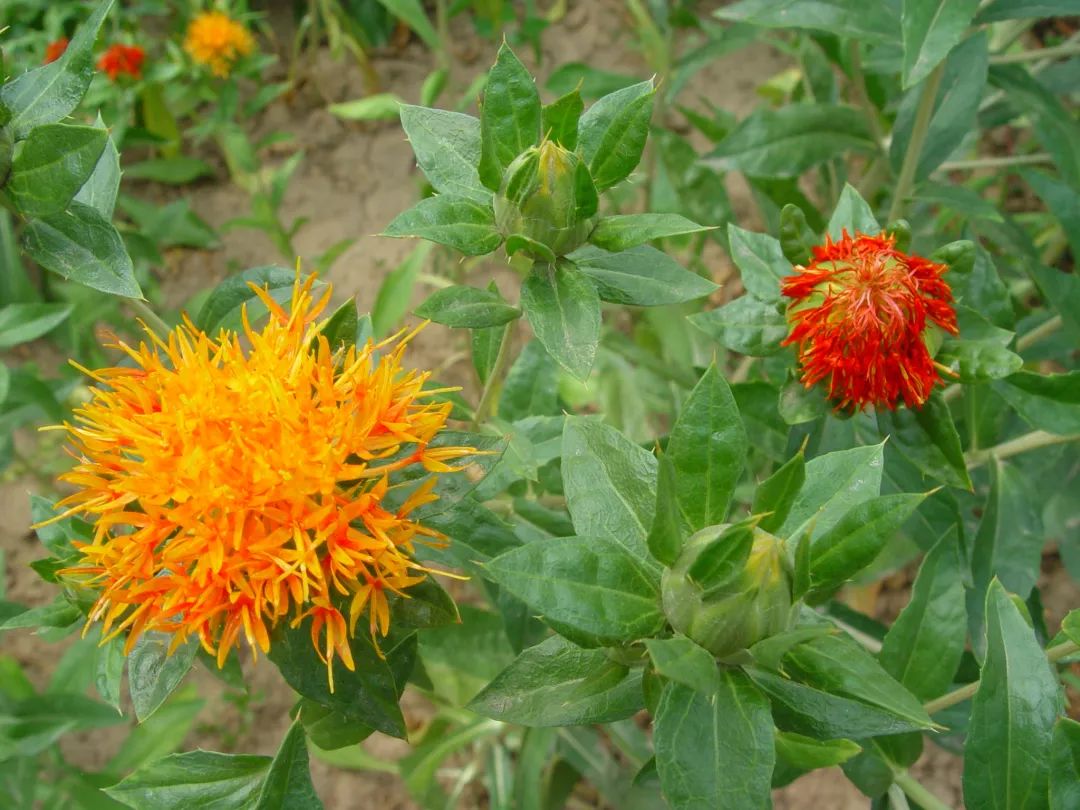
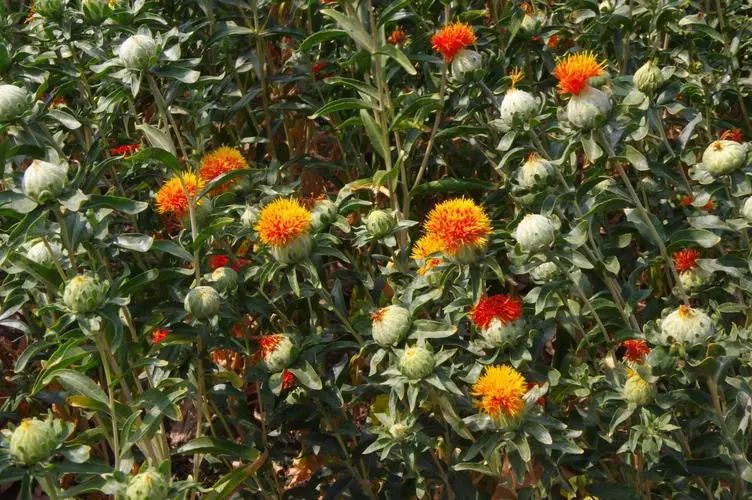
Preparation: Remove impurities, discard stems and leaves, and dry.
Meridian Affinity: Enters the Heart (Xin) and Liver (Gan) meridians.
Properties: Pungent in flavor; warm in nature.
Precautions: Avoid use during pregnancy.
Functions and Indications: Invigorates blood circulation and regulates menstruation; alleviates pain and removes blood stasis. Indicated for amenorrhea, dysmenorrhea, postpartum abdominal pain due to blood stasis, chest pain due to blood stasis, traumatic injuries, joint pain, stroke sequelae, and rashes.
Dosage: For internal use: decoction, 3-10 g. Use less for nourishing blood and harmonizing blood; use more for invigorating blood and removing stasis.
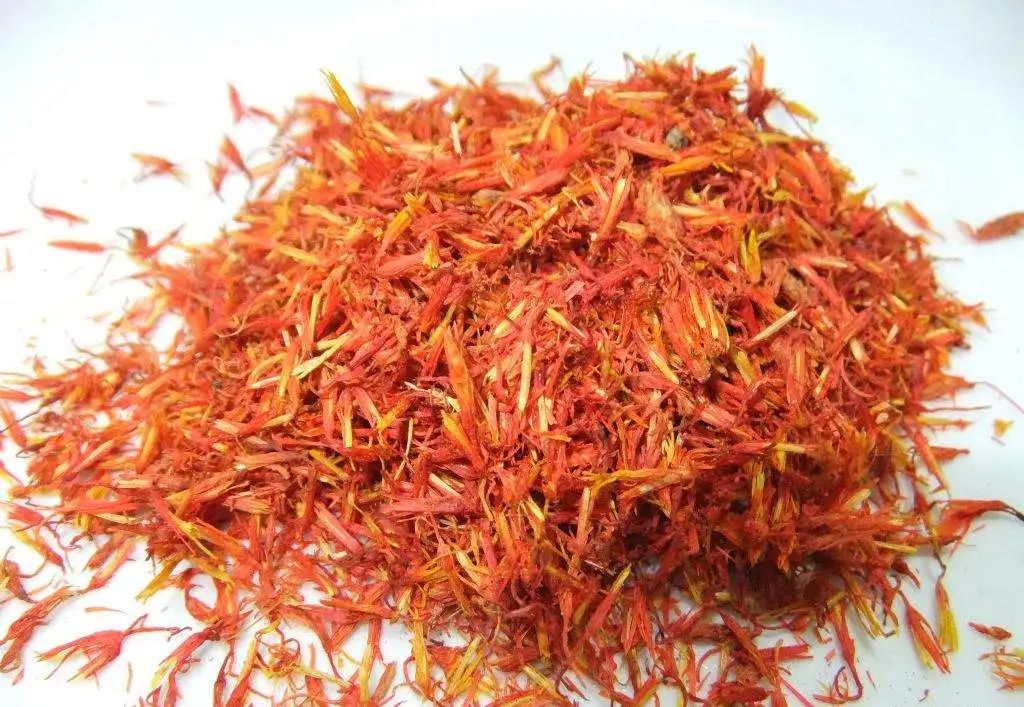
The efficacy and functions of safflower:
1. Dissolves stasis and reduces rashes: Safflower can invigorate blood and open meridians to dissolve stasis and reduce rashes, useful for treating dark-colored rashes caused by blood heat stagnation. It can also effectively prevent and improve skin issues such as measles and rashes, making it a great choice for women’s beauty and skincare.
2. Lowers blood lipids: The safflower oil component has lipid-lowering effects, reducing total cholesterol, triglycerides, and non-esterified fatty acids.
3. Invigorates blood circulation: Safflower is pungent and warm, entering the blood level, which can invigorate blood, remove stasis, and alleviate dysmenorrhea. It is a good health supplement for women and the elderly, but should not be used in excess. In fact, safflower’s ability to dissolve stasis is stronger than its blood-invigorating effect, making it commonly used for regulating menstruation, treating dysmenorrhea, menstrual irregularities, amenorrhea with abdominal pain, and postpartum complications.
4. Reduces swelling and alleviates pain: Safflower has the ability to reduce swelling and alleviate pain, suitable for various blood stasis conditions such as chest pain, rib and abdominal pain, subcutaneous bruising, and stroke sequelae. Additionally, it is very effective for pain in the limbs caused by traumatic injuries or strains.
5. Lowers blood pressure: The yellow pigment in safflower can dilate peripheral blood vessels, inhibit platelet aggregation, enhance fibrinolysis, and reduce whole blood viscosity, thus lowering blood pressure.
Contraindications for safflower:
Pregnant women should avoid: Safflower is believed to stimulate the uterus, and pregnant women should avoid consuming it to prevent miscarriage.
Excessive consumption: Safflower is a spicy condiment, and excessive consumption may lead to gastrointestinal discomfort, dizziness, dry mouth, and other adverse symptoms.
Allergic reactions: Some individuals may experience allergic reactions to safflower, such as rashes or difficulty breathing. If allergic symptoms occur, consumption should be stopped immediately.
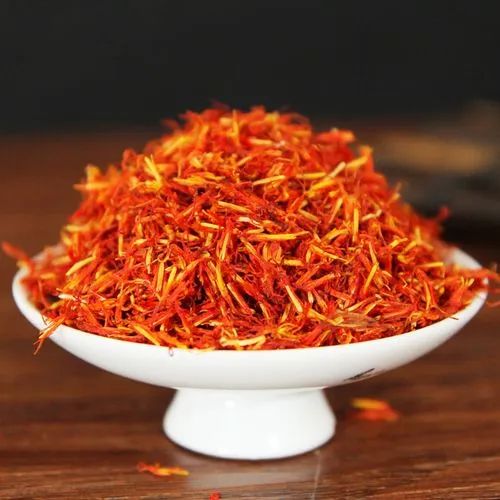
Selected Formulas:
① For treating women’s menstrual obstruction, such as blood stasis: Safflower (finely chopped), Su Fang Mu (crushed), and Dang Gui (Angelica Sinensis) in equal parts. Finely chop, use one tael, with 1.5 liters of water, first decoct the flower and wood, then add one cup of wine and Dang Gui, decoct again, and take warm before meals. (From “Zhu’s Collection of Verified Medical Formulas”)
④ For treating various wind conditions in women and abdominal blood gas stabbing pain: One tael of safflower. Use one large liter of wine, decoct until reduced by half, take half at once, and if symptoms persist, take again. (From “Essentials of Prescriptions from the Golden Chamber” – Safflower Wine)
⑤ For treating all swellings: Safflower, properly prepared, crush to extract juice and consume. (From “Secret Formulas from the Outer Chamber”)
⑥ For treating throat obstruction and blockage: Safflower juice, one small liter, take as needed. If there is no moisture in winter, use dried flowers to soak and extract juice as before. (From “Sea Collection of Verified Formulas”)
⑧ For treating traumatic injuries and wall crush injuries: 1 part Chuanma, 2 parts Mu Xiang, 3 parts safflower, and 4 parts licorice. All used raw, ground into powder, and taken with yellow wine. (From “Emergency Formulas”)
⑨ For treating bedsores: Safflower in appropriate amount, soak in wine and apply externally. (From “Yunnan Herbal Medicine”)
To learn more about Traditional Chinese Medicine, herbal materials, herbal formulas, and folk remedies, ▼ click the card below ▼ to inquire!
For example: low back pain, gynecology, andrology, kidney tonification, lumbar disc herniation, back pain, leg pain, knee pain, cervical spondylosis, liver disease, stomach disease, constipation, frequent urination, diarrhea, abdominal protrusion, dysmenorrhea, breast hyperplasia, breast cancer, postpartum recovery, acne, white hair, hair loss, breast enhancement, beauty, skin diseases, senile spots, aging, yin deficiency, colds, cough, fever, insomnia, stones, pharyngitis, sore throat, headaches, toothaches, snoring, oral ulcers, bad breath, rhinitis, tinnitus, eye diseases, thyroid issues, dandruff, athlete's foot, hemorrhoids, cold hands and feet, rheumatism, night sweats, brain cancer, hypertension, diabetes, asthma, heart disease, cardiovascular diseases, fatty liver, gout, dementia, varicose veins, qi tonification, blood tonification, calcium supplementation, weakness, obesity, pediatric diseases, leg slimming, waist slimming, dampness, spleen strengthening, hiccups, body odor, cramps, smoking cessation, meridians, Chinese patent medicines, foot baths... and more.
Thank you for sharing and click to see more, good luck continuously!

